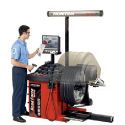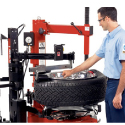JOIN US NOW !
Subscribe to our newsletter to get updates and discount offer!.

Most of today’s premium vehicles are equipped with state-of-the-art, low-profile radial tires, mounted on 17-,18-,19-, and even 20-inch alloy wheels that are easily damaged by road imperfections, curbs, and potholes, resulting in high-speed vibration problems that are not easily repaired with conventional wheel balancing techniques.
Star Tires Limited is equipped with three Hunter Road Force Wheel Balancers, the most state-of-the-art method of detecting wheel and tire imperfections and defects that result in high-speed drivability and vibration problems. The GSP 9700 Balancer is also capable of “straight track” diagnosis, identifying tire and wheel assemblies that have a tendency to roll out, or cause steering pull problems that cannot be associated to alignment angles.
Generally, wheel balance vibrations are vibrations that can be felt at higher speeds only, and are typically felt for a specific range of speed. For example, the vehicle may vibrate from 90-100 kph, but not from 100-110, then vibrate again at a slightly higher range of speed. Balance vibrations do not disappear when you take your foot off the gas, or when you shift the vehicle into neutral. Incorrectly balanced wheels are not noisy – noises are caused by bad wheel bearings or tires with scalloped tread wear. Balancing will not correct these issues. Balancing will also not correct low-speed wobbles, usually caused by a defective tire or very badly bent rim.
Because of this, both tire and wheel are assembled according to the manufacturer’s specifications by our professional staff and are Hunter-Balanced and Road Force® approved!
Tires are made up of internal beads, body plies, and belts that are encased in rubber, assembled and cured. Alloy wheels are cast, cooled, and machined. And even though they both are built to tight tolerances, there are bound to be some unavoidable weight imbalances during the manufacturing process.


When you consider that a typical passenger car tire mounted on an alloy wheel weighs about 40 pounds, it’s amazing that the total amount of imbalance is typically no more than three to four ounces, or about one-half of one percent. So, if the tire and wheel combination isn’t balanced with add-on weights, being off even an ounce or two can cause vibration at highway speeds. Heavier tire and wheel combinations, especially those used on light trucks, require more weights to maintain the same low percentage of imbalance.
In order to assure customer satisfaction, tires and wheels purchased at Star Tires Limited are tested before being mounted on a vehicle using the Hunter Engineering GSP9700 Vibration Control System to evaluate and eliminate nearly all possible wheel- and tire-related vibration causes.
The GSP9700 Vibration Control System used by Star Tires Limited service specialists to finish tires and wheels goes far beyond the traditional capabilities of a wheel balancer. In addition to rectifying the inevitable wheel and tire imbalance, the GSP9700 Vibration Control System also “road tests” the mounted assembly to confirm virtually every aspect of a tire and wheel combination that might contribute to a vibration.
The GSP9700 Vibration Control System includes Hunter’s exclusive Road Force Measurement System to help detect potential tire uniformity causes of vibration that are not balance-related. This system utilizes a “road roller” which applies up to 1,400 pounds (635 kg) of force against the wheel and tire assembly to measure their combined uniformity. This simulated road force test helps verify if the assembly is “round” when rolling under load.
 The GSP9700 Vibration Control System can also measure lateral and radial rim run out (out of roundness or side-to-side movement) to identify and separate wheel run out from tire run out. The system then calculates the contributions of the wheel and the tire to a potential vibration and presents the service specialist with easy-to-follow instructions on the appropriate corrective actions.
The GSP9700 Vibration Control System can also measure lateral and radial rim run out (out of roundness or side-to-side movement) to identify and separate wheel run out from tire run out. The system then calculates the contributions of the wheel and the tire to a potential vibration and presents the service specialist with easy-to-follow instructions on the appropriate corrective actions.
If the wheel and tire are at the edge of acceptable tolerances, Hunter’s patented Force Matching(TM) feature is used to align the high point of the tire with the low spot of the rim. This helps maximize ride quality by minimizing the effects of tire force variation and rim run out. If a wheel or tire is found to be out of tolerance, it is replaced with another wheel or tire that is within tolerance.
Once acceptable uniformity has been confirmed, or corrective actions have been completed, the technician can continue with precision wheel balance.
This discount is not valid in conjunction with other offers


Subscribe to our newsletter to get updates and discount offer!.
